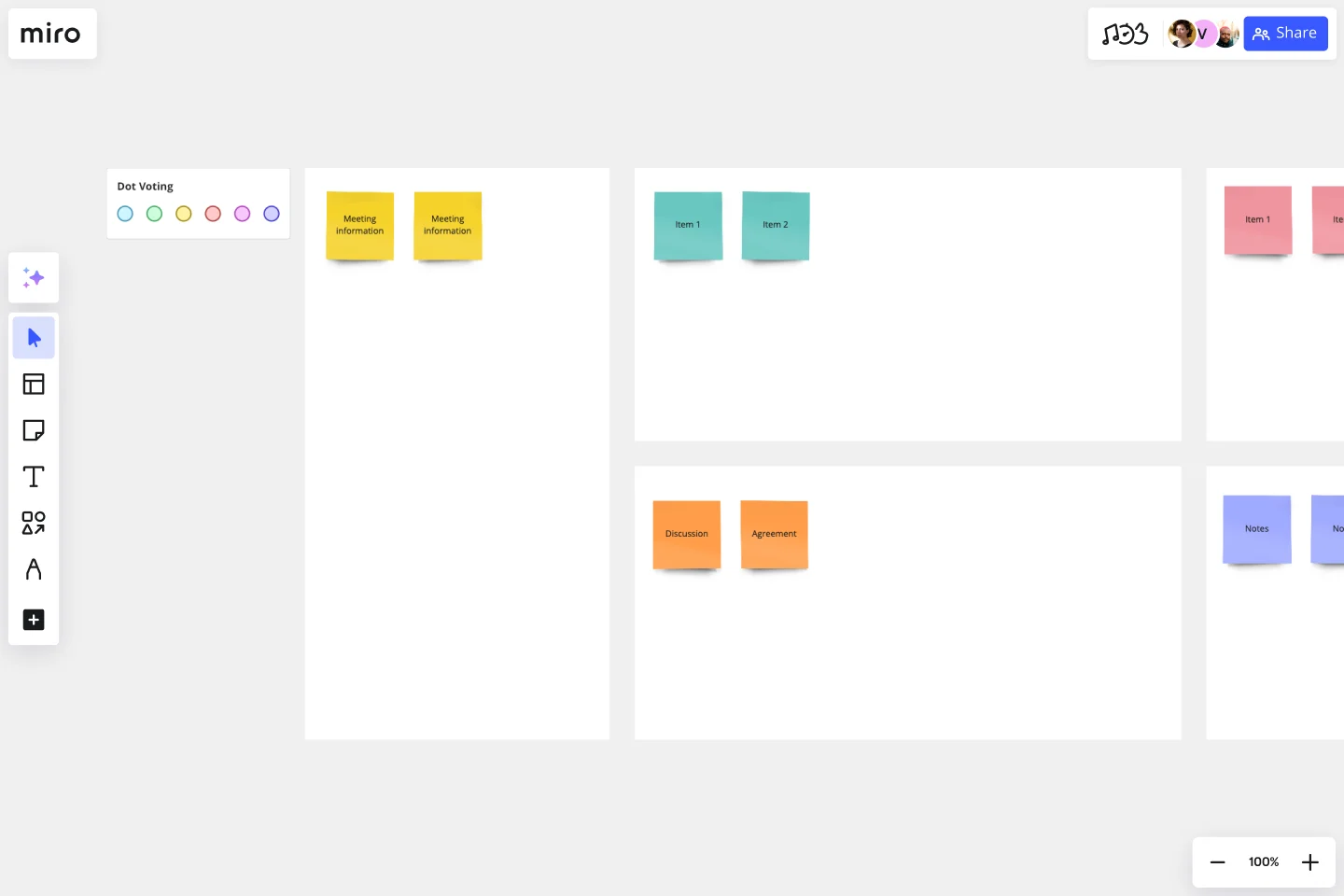Meeting Notes Template
Create a lasting record of what happened during a meeting.
About the Meeting Notes template
If someone asked you how many meetings you have in a given week, you’d probably find it hard to answer -- not because you don’t pay attention, but because you have so many! When you’re in and out of important meetings all day, it can be difficult to remember who said what, or what goals everyone agreed on.
Meeting notes are simply a record of your meeting. Most teams prefer to assign a notetaker at the beginning of each meeting, so one person can focus on capturing the contents of the meeting instead of having everyone scramble to capture what they can. Many teams rotate the notetaker so everyone has an equal stake in the meeting.
Who should use the meeting notes template?
Any team that wants to keep a written record of what happened during a meeting. This is especially important for meetings with action items, deadlines, and decisions. You can assign one person to be responsible or you may want to rotate duties so that a different person is responsible for updating the meeting notes each time.
How to create meeting notes
Step 1: Assign a notetaker before the meeting.
Step 2: Decide on the topics you’re going to cover for the meeting. The notetaker can make a note of these topics.
Step 3: During the meeting, ask the notetaker to summarize the notes from the previous meeting to give you a starting point.
Step 4: Have the notetaker take down the names of the participants, agenda times, action items and due dates, and the main points from the meeting.
Step 5: As the meeting continues, the notetaker can continue to take note of any decisions made by the participants, the most important points covered, and any future decisions that need to be made.
Step 6: The notetaker can share the meeting notes with the team, if appropriate.
How do you use the meeting notes template?
Start with our pre-made template, making any changes you’d like to suit your particular needs. Invite team members to join your board and collaborate. Use the @mention or video chat if you need to get input from others. You can upload other file types such as documents, photos, videos, and PDFs to store all the relevant information in one place.
Get started with this template right now.
Meeting Organizer Template
Works best for:
Meetings, Workshops, Project Planning
When it comes to ideas generated during a meeting, you want quantity AND quality. So why choose? Our meeting organizer template will maximize your meeting’s chances of yielding lots of great ideas. It will give you a simple, efficient way to design any activity (including meetings and daily planning) and make sure remote teammates know just what the meeting aims to accomplish. And you can give your meeting organizer power by connecting Miro to your favorite apps and services: Atlassian’s JIRA, Google Drive, Slack, Trello, DropBox and OneDrive.
One-on-one Meeting Template
Works best for:
Meetings
Ensure your meetings are productive by using a one-on-one meeting template. Create and stick to your agenda items, understand what’s going well, what isn’t working, and how to improve. Discuss what’s been accomplished and what’s still in progress.
Stakeholder Mapping Template
Works best for:
Business Management, Mapping, Workflows
A stakeholder map is a type of analysis that allows you to group people by their power and interest. Use this template to organize all of the people who have an interest in your product, project, or idea in a single visual space. This allows you to easily see who can influence your project, and how each person is related to the other. Widely used in project management, stakeholder mapping is typically performed at the beginning of a project. Doing stakeholder mapping early on will help prevent miscommunication, ensure all groups are aligned on the objectives and set expectations about outcomes and results.
Agile Product Roadmap
Works best for:
Roadmap, Planning, Mapping
The Agile Product Roadmap template enables teams to visualize and communicate the strategic direction of their product development in an agile environment. It allows for flexibility and adaptation to changing requirements while providing a clear overview of priorities and timelines. By incorporating feedback loops and iterative planning, teams can ensure alignment with stakeholder expectations and deliver value incrementally.
Blue Ocean 4 Actions Framework Template
Works best for:
Leadership, Decision Making, Strategic Planning
For entrepreneurs, so much comes down to new users—how to attract them, impress them, and convert them to loyal customers. This template, designed by the authors of Blue Ocean Strategy: How to Create Uncontested Market Space and Make the Competition Irrelevant, will help you maximize value for you and your customers alike. Using the template’s four steps (divided into easy columns), you’ll easily evaluate your products in more innovative ways and make sure money is being spent in areas that really matter.
3 Horizons of Growth Template
Works best for:
Leadership, Strategic Planning, Project Planning
Featured in The Alchemy of Growth, this model gives ambitious companies a way to balance the present and the future—in other words, what’s working in the existing business and what emerging, possibly-profitable growth opportunities lie ahead. Then teams across the organization can make sure that their projects map to and support the organization’s goals. The 3 Horizons of Growth model is also a powerful way to foster a culture of innovation—one that values and depends on experimentation and iteration—and to identify opportunities for new business.
